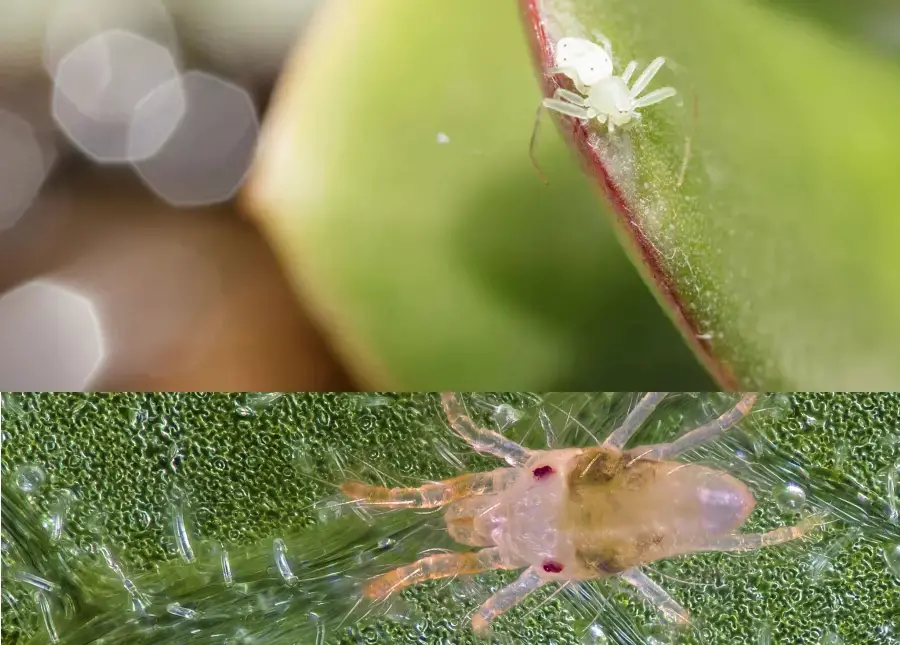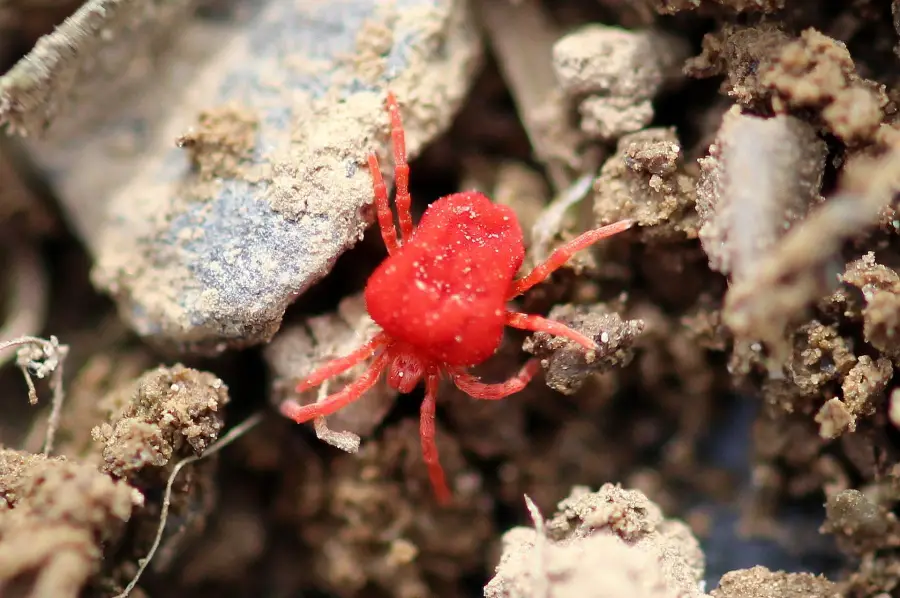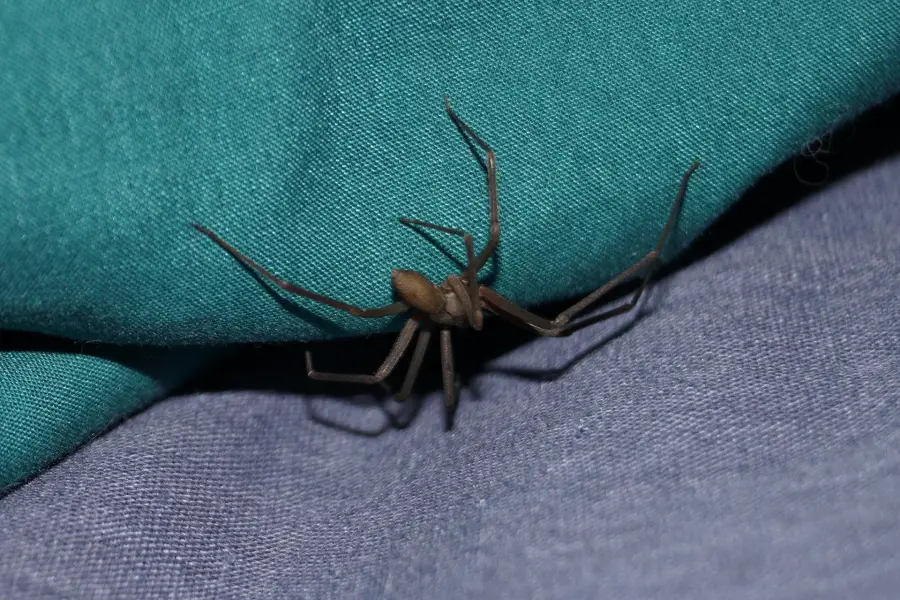A vibrant and lush lawn may be an aesthetic element to us humans, but (more often than not) it is also a rich ecosystem that supports many species. Arachnids, for instance, are a common sight in lawns all over and today we will be paying particular attention to a very tiny one. What are they and are they dangerous?
Most tiny white spiders found in lawns and gardens are spider mites rather than spiders. They are herbivores that feed on the sap of plants and are not dangerous to humans. Rarely, newly hatched spider broods can have a light or white appearances, but they too pose not threat to humans.
Yes, we’re talking about the little white “spiders” that oftentimes set up camp in your lawn, plants, or vegetables. We will discuss their basic biology, their potential impact on your lawn or garden, as well as their potential threat to people. Let’s get started.

Contents
What Are Little Tiny White Spiders On Plants?
Let’s get things clear, right from the beginning: most every one of the little white “spiders” in your garden are NOT spiders at all…they are mites. There can be rare exceptions, but more on that later. What exactly are these white ‘spider looking’ bugs?
The tiny white spiders in your lawn or garden are usually not spiders but mites, Spider mites, to be exact. They are harmless to humans, but due to rapid reproduction and insatiable appetites for the sap of plants and grass, they are extremely undesirable to gardeners and farmers alike.
While that may be a little confusing, these mites are so-called because of their resemblance to their fellow arachnids. Yes, while spider mites look like spiders (eight legs, countless eyes, etc.), they are actually a different species.
What Species Are Spider Mites?
Though not technically spiders, spider mites are part of the arachnid (class Arachnida) group along with spiders, Daddy Longlegs, scorpions, and ticks. Yet, do they have a specific species name?
In the scientific community, the spider mite is also known as Tetranychus urticae. In the landscaping community, you might hear folks refer to these critters as “lawn mites”, “grass mites” or “clover mites”. Whatever names these mites may have collected over the years, they are one in the same.
These tiny bugs (usually measuring 0.04 inches in length) are herbivorous, surviving on the sap of plants and grass of all varieties. They are particularly fond of vegetable plants (leafy greens, tomatoes) but they will also target your lawn…and in numbers.
In fact, spider mite numbers, coupled with their extremely high reproductive rate, make them a pest wherever they choose to pop up. Any farmer or landscaper will tell you that spider mites are BAD news.
Why Are Spider Mites Undesirable?

Spider mites will suck on a plant’s sap until its leaf surfaces develop yellowish spots. In the case of grass, the mites will extract sap from the roots or blades, which also leads to discoloration and death of the grass. If unchecked, this can lead to a yellowed lawn or even bare patches.
Another reason is that they breed so extensively and so fast that their populations can expand to the point of devastation for gardens and parts of lawns in a matter of weeks not months. If the problem of a spider mite infestation is not taken cared of soon, it could spell disaster for many plants.
Are Spider Mites Only White?
If you have seen this same type of bug in other colors, you are not imagining things. There are some types that do come in other hues.
While spider mites are usually white, they can also vary wildly. Red, grey, and black spider mites are also common. Coloration also depends on the maturity stage, as well as food source. Their small size can change how well they are observed. Many have hard to see spots and other markings.
It is also more accurate to say that many spider mites have a translucent quality to them that makes them more or less of the color we see them as having. While most seem white, on close examination they usually are not pure white at all.
Could Tiny White Spiders On Plants Actually Be Spiders?
So, you understand that most of these that people see are actually spider mites, but you are convinced that what you are seeing is different and actually are spiders. Well, you could be correct.
Many types of ‘spiderlings’ or baby spiders do have light or at least lighter coloring than their parents. Some even take on an almost white appearance in early stages. Though rare to find, this can be the case if a large egg hatching has just taken place in the near vicinity.
There are a couple of things to keep in mind about this type of young spider…
- Spiders are very good for your garden or lawn. They eat pests that can harm or ‘bug’ your plants or even you.
- Tiny spiders in almost every case do not have the ability to break human skin with bites or enough poison if they even have it to do humans harm. They are not dangerous.
Baby Brown Recluse Spiders Can Be White

That being said, some of these could grow to become adult spiders that you wouldn’t want to be bitten by. For example, baby Brown Recluse spiders often are light beige to white in color in their infancy. Later as they grow they become darker, very aggressive to other spiders and even humans.
These will be larger than spider mites and if you suspect they are Brown Recluse spiders, it is best to try and exterminate them to save your children, pets, or yourself potential risk in the future. Many in my family in the south have come into contact with these spiders and the ones that have been bitten have had some severe reactions.
Make no mistake, you do not want to get bitten by a Brown Recluse.
Young Hobo Spiders Can Be Light To White In Color

Hobo spiders may look very similar to Brown Recluse spiders and sometimes are mistaken for them. Though their venom is not considered on the same level as the Brown Recluse, it can have some painful and long lasting effects. The CDC warns that headaches lasting for up to a week, blistering, and pain at the bite site can last for several months.
If you suspect that the small white spiders you are seeing could be very young Hobo spiders, it would not be a bad idea to eradicate them before they grow enough to be able to envenomate humans.
Spotting tiny light colored or white baby Hobo spiders would be a rare find indeed. You are more than likely just seeing spider mites.
To read more great articles from Lawncare Grandpa…
- What Is Eating My Strawberries? Let’s Find Out!
- Do Squirrels Eat Grubs In Your Lawn? Moles, Birds, Etc
- Will Bleach Kill Grass And Weeds In Your Lawn And Walkways?
Why Are Spider Mites Mistaken For Spiders?
If spider mites aren’t actually spiders, then why do many people mistake them for spiders?
A trademark attribute (which also contributes to the “spider” misidentification) is the spider mite’s ability to spin silk webbing. This webbing is primarily used to help the mites cling to host plants. These webbed “colonies” are the easiest way to identify spider mites.
Individuals are extremely hard to see with the naked eye, though if you get close enough it is possible. Their small size makes it hard to distinguish their 8 legged form from that of larger spiders.
Female mites also lay their eggs on the webbing so the hatchlings have direct access to food as quickly as possible.
Speaking of speed, almost every aspect surrounding spider mites involves doing things quickly.
Reproduction is one area where this idea holds true. The life cycle of a mite (from egg to sexual maturity) is a little over a week! Eggs hatch within 3 days of being laid and the emergent larvae reach adulthood after five days!
What’s even more mind-blowing is that one female mite can lay up to 20 eggs in a day, which translates to about 500+ eggs in its 4-week lifespan.
How Do I Get Rid Of White Spiders?
This rapid rate of reproduction not only gives you more mites to deal with, but also equips them with ever-improving levels of resistance to whatever chemical pesticides you use. If you continually leave spider mite populations unchecked, you will eventually find yourself spraying greater quantities/ concentrations of the same chemical.
Commercially Available Spider Mite Pesticides
Pyrethrum (available on Amazon) is the go-to solution for mites, and for good reason. It is packed with pyrethrins, a family of toxins that paralyze and kill small bugs and insects. These pyrethrins are often sourced from chrysanthemum flowers.
With time, your attempts at pyrethrin-based warfare may prove futile, as the bugs grow increasingly resistant. This could force you to seek alternative ways to handle your spider mite problem.
An increasingly popular mite pesticide (or miticide) is Neem oil (also available at Amazon). As an extract from the Neem nut, this oil is an all-natural mite killer and repellant. Direct contact with the oil will kill mites, while the odor serves as a warning for would-be invaders.
Cinnamite (ready to use spray from Amazon), a cinnamon extract, is another chemical that has been found to deal significant blows to mite populations. Unfortunately, cinnamate only kills matured mites. It does not harm the eggs.
Rosemary oil is another great organic solution for spider mites that will kill adults, larvae, and eggs. We highly recommend using it for vegetable gardens, in particular, because it is non-toxic to humans.
Homemade Pesticides For Spider Mites
One such solution is rubbing alcohol mixed with water. A good ratio to start with is one part rubbing alcohol to three parts water. The concentration may be tweaked if you aren’t seeing the desired results.
If pesticides don’t work, you can turn to other mites!
That’s right, there are species of mite that prey on other mites and you can enlist them to help you fight off a spider mite invasion.
One particularly deadly predatory mite is Phytoseilus persimilis, which is larger and faster than spider mites. Persimilis feeds on adult mites, larvae, and eggs.
The advantage of predatory mites is their ability to pick off individual mites without affecting the host plants. This is one of the reasons commercial farmers are turning their backs on conventional miticides. Persimilis is so efficient that one individual can pick off a couple of dozen spider mites in one day.
However, the best way to deal with spider mites in your lawn or garden is to prevent them from coming in the first place.
One common way they can get in is through potting mixes riddled with mite eggs. As you add the new soil into your garden, you inadvertently introduce a whole generation of sap-sucking monsters. This is why it is important to be careful about where you get your potting mix and compost from.
Mites can also use their web-spinning abilities to create little parasails so they can float into your garden. Very little can be done to protect your lawn from this but vegetables can be protected by erecting a sealed greenhouse.
Spider mites tend to favor dry conditions, so try to water your grass and vegetable gardens frequently to keep them at bay. The dry winter months are when you are most likely to encounter spider mites. You should also mow your lawn frequently and minimize shrubbery on your property so the mites won’t have a hiding place.
How To Kill Brown Recluse, Wolf, And Hobo Spiders
It may seem like a simple job to kill the spiders as you see them, but for the one you see, there are many more you don’t see. That is where preventative as well as spot spraying inside and outside your home can help.
I use Ortho Home Defense Insect Killer in my home several times per year. I have a historic home, which means I have cracks and small openings that I can’t see. I use this Ortho product every few months and all types of insects have decreased in my house exponentially.
It takes care not only of these specific spiders, but also ants, house millipedes, and any other bug that crawls around my doors or baseboards. You can even spray this odorless insecticide directly on the spider if you don’t have a boot handy.
Are Tiny White Spiders Poisonous?
In a way it really doesn’t matter if tiny white spiders or spider looking bugs are poisonous or not. The size of these tiny bugs makes it nearly impossible for them to break human skin even if they did bite. Biting is also not common among young spiders since they are more defensive than aggressive at that state.
Whether Brown Recluse or Hobo spiders, these tiny arachnids couldn’t harm you even if they got too big for their little britches. Their poison production and fang size has not reached a point to be a threat.
Besides, spider mites don’t bite. they may be a significant menace to plants and your lawn, but they pose no direct threat to humans. They do not bite people and they do not have any poison or venom that would be harmful to a human.
Final Touches On Tiny White Spiders In Lawns Or Gardens…
Hopefully this dive into the tiny white spiders you find in your lawn or on the plants in your flower beds or gardens has helped you put a mystery to rest.
If you are dealing with spider mites, which is more than likely the case, there are some definite solutions you can and should take before the problem grows out of hand.
If you are dealing with a few variations of very young poisonous spiders, there are easy and inexpensive sprays you can get that will take care of the problem fast.
Here are other articles you will like…
- What Is The Best Shade Tolerant Bermuda? (Solved)
- Walk-Behind Sprayer: What Is A Push Sprayer Used For?
- PEX Irrigation System: Can You Bury PEX For Lawn Sprinklers?
References
https://www.crabgrasslawn.com/spiders-in-lawn-grass/
https://organolawn.com/services/lawn-insect-control/grass-mites/
